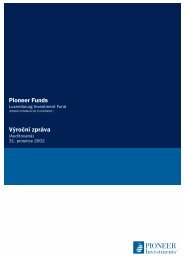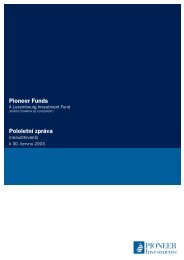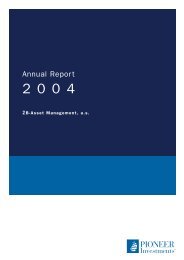Mise en page 1 - UniCredit Bank Slovakia as
Mise en page 1 - UniCredit Bank Slovakia as
Mise en page 1 - UniCredit Bank Slovakia as
Create successful ePaper yourself
Turn your PDF publications into a flip-book with our unique Google optimized e-Paper software.
Pioneer Funds Annual Report 2012<br />
Annual Comm<strong>en</strong>tary on the Financial Markets (continued)<br />
Equity Markets<br />
Europe<br />
Since June 2012, we have gradually be<strong>en</strong> adding to our European equity exposure despite widespread concerns over a euro break-up, <strong>as</strong> we<br />
believed that those pessimistic forec<strong>as</strong>ts were reflected in some valuations. While the worst-c<strong>as</strong>e sc<strong>en</strong>ario h<strong>as</strong> be<strong>en</strong> averted, we share the<br />
prevailing view that the European economy will stay in recession for most of 2013. However, we believe that European equity valuations<br />
remain cheap and consist<strong>en</strong>t with these downbeat macroeconomic forec<strong>as</strong>ts. According to our estimates, the cyclically-adjusted price/earnings<br />
ratio in Europe is far below the long-term average and near its historical minimum.<br />
A fair <strong>as</strong>sessm<strong>en</strong>t of European stockmarkets h<strong>as</strong> to take into account that companies listed on European exchanges sell most of their goods<br />
outside of Europe and t<strong>en</strong>d to follow the global economic cycle. The cheapest companies were in the Financial sector, whose liquidity shortage<br />
w<strong>as</strong> e<strong>as</strong>ed by the European C<strong>en</strong>tral <strong>Bank</strong>’s support, with a b<strong>en</strong>eficial impact on stock prices. However, long-term earnings estimates may<br />
improve very slowly <strong>as</strong> long <strong>as</strong> the credit crunch continues in recession-hit countries of the euro area. Higher capital ratios imposed by<br />
domestic and international regulators are also looming, although some investors may be comfortable with the additional constraints posed by<br />
the new requirem<strong>en</strong>ts, notably on loan selection.<br />
United States<br />
Concerns about a recessionary fiscal cliff seemed to be only mildly reflected in US stockmarket action, wh<strong>en</strong> the broad S&P 500 index<br />
wrapped up a double-digit gain in 2012, led by the most cyclical (economy-s<strong>en</strong>sitive) sector groups. Ev<strong>en</strong> the VIX index of implied volatility<br />
appeared to be on the rise wh<strong>en</strong> compared with rec<strong>en</strong>t low values, but w<strong>as</strong> about half <strong>as</strong> much <strong>as</strong> in the summer of 2011, wh<strong>en</strong> the standoff<br />
over fiscal policies pushed the S&P 500 down by 12% in under a month. The Financials index turned out to be the best performer among the<br />
10 economic sectors in the S&P 500 and this sector group h<strong>as</strong> long be<strong>en</strong> one of the most vulnerable following the continued volatility<br />
surrounding the US economy. The Federal Reserve’s (Fed) overly loose monetary policy h<strong>as</strong> helped greatly, though on a more fundam<strong>en</strong>tal<br />
b<strong>as</strong>is the flow of economic data h<strong>as</strong> also somewhat improved, thanks to upbeat data from the Housing sector.<br />
The risk of resurg<strong>en</strong>t inflation did not appear to be anticipated by equity investors (though not so among inflation-linked bondholders). This<br />
stance w<strong>as</strong> especially good news for banks, which were able to exploit a positive carry by borrowing money at the short <strong>en</strong>d of the yield curve<br />
and l<strong>en</strong>ding to companies and households. This margin would be largely untapped if demand for loans remained weak, but these have steadily<br />
recovered from the recession especially for the most solid l<strong>en</strong>ders.<br />
The housing market h<strong>as</strong> also b<strong>en</strong>efitted from quantitative e<strong>as</strong>ing. It took some time for falling mortgage rates to leave a mark, but home sales<br />
and prices stepped up the pace of recovery in 2012. Going forward, international tr<strong>en</strong>ds may be crucial for other cyclical sectors. Exporters of<br />
b<strong>as</strong>ic materials and resources are unlikely to g<strong>en</strong>erate p<strong>as</strong>t earnings growth, where<strong>as</strong> makers of consumer goods may b<strong>en</strong>efit from strong and<br />
incre<strong>as</strong>ed sales especially of discretionary items.<br />
Asia and Emerging Equities<br />
Emerging market countries and sectors have delivered quite differ<strong>en</strong>t results throughout the year.<br />
Country-wise, at the <strong>en</strong>d of 2012, Chinese stocks were supported by the growing perception of a soft-landing sc<strong>en</strong>ario. We believe that the<br />
trough of the earnings cycle h<strong>as</strong> be<strong>en</strong> reached and expect corporate profits to start improving in 2013, <strong>as</strong> GDP growth may have bottomed out<br />
at 7% year-on-year in 2012. Chinese blue-chip stocks (mostly listed in Hong Kong) have largely beat<strong>en</strong> world market averages in late 2012,<br />
but we believe that despite the latest rally Chinese stocks are still undervalued compared to broad emerging market averages, notably in the<br />
key <strong>Bank</strong>ing sector which h<strong>as</strong> long be<strong>en</strong> under pressure amid investors’ disappointm<strong>en</strong>t over a too-slow monetary e<strong>as</strong>ing. Chinese consumer<br />
stocks may also get steady support from a possible change in China’s growth model from investm<strong>en</strong>t-led to a consumer-led one.<br />
Other major emerging markets had less room to grow amid fewer available economic policy tools. Throughout 2012, Brazil’s c<strong>en</strong>tral bank h<strong>as</strong><br />
cut its b<strong>en</strong>chmark rates in half to a record low in an effort to revive GDP growth, but structural factors such <strong>as</strong> low labour productivity and<br />
still-excessive regulations were a hindrance. A weaker real may b<strong>en</strong>efit exporters, but most of them belong to resource-related sectors which<br />
are likely to suffer from China’s change in growth model. Russia is another resource-driv<strong>en</strong> economy, but it appeared to have some more room<br />
for growth in domestic household sp<strong>en</strong>ding to offset.<br />
Indian stocks have be<strong>en</strong> broadly supported, although fundam<strong>en</strong>tal re<strong>as</strong>ons for concern still persist amid a narrow breathing space for economic<br />
stimulus: on the monetary side, the c<strong>en</strong>tral bank’s willingness to let interest rates fall further and relax the inflation target to revive a flagging<br />
economy rec<strong>en</strong>tly met with some criticism and provided more uncertainties than comfort.<br />
However, we believe that emerging-market equities, <strong>as</strong> a whole, remain the best long-term investm<strong>en</strong>t opportunity.<br />
Curr<strong>en</strong>cies: The search for competitive curr<strong>en</strong>cies becomes broad-b<strong>as</strong>ed<br />
Major curr<strong>en</strong>cies experi<strong>en</strong>ced relatively modest swings in 2012. In our view, volatility is unlikely to pick up again in 2013 <strong>as</strong> monetary<br />
policies carried out in developed countries after the latest great recession t<strong>en</strong>ded to resemble each other.<br />
Until late into 2012, the US dollar’s trade-weighted index declined and fell to historical lows despite the sovereign-debt crisis and the <strong>en</strong>suing<br />
recession in the euro area. The Federal Reserve’s stance h<strong>as</strong> oft<strong>en</strong> had a lot of influ<strong>en</strong>ce on financial markets, and policies (like QE) boosting<br />
money supply could weak<strong>en</strong> the dollar, but wh<strong>en</strong> the ECB resorted to its own liquidity-<strong>en</strong>hancing tools to contain the damage of the debt<br />
crisis. The ECB and the Fed were committed to doing whatever it took to fulfil their respective goals (saving the euro and moving the US<br />
economy to a f<strong>as</strong>ter track). Both curr<strong>en</strong>cies did not appear to be supported by a strong commitm<strong>en</strong>t to fighting inflation. As a c<strong>en</strong>tral bank<br />
policy goal, consumer price stability looks like a legacy of the p<strong>as</strong>t and some investors may not appreciate such a radical change of priorities in<br />
favour of economic growth. The US dollar’s cheap valuation <strong>as</strong> a hedge against t<strong>en</strong>sions over the euro sovereign-debt crisis partially offset the<br />
Fed’s overly loose stance.<br />
8 Pioneer Funds - Annual Report










